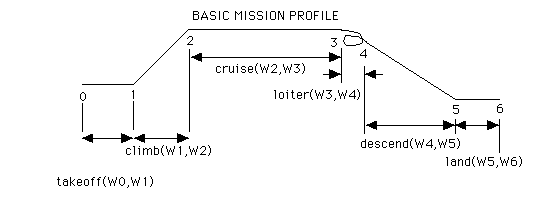Objective
The object of the term problem is to create a versatile
program which can be used for airplane/mission analysis and design.
For example when run it can answer the following problems:
- a. Analysis:
- Given the configuration and the mission, what are the
minimum runway lengths?
- b. Synthesis:
- Given the complete mission and airframe configuration
what engine size is required?
The objective will be achieved in steps, or Parts, during the remainder
of the semester and will address only the mission type sketched as
a mission profile above concentrating on a commercial jet transport.
We will establish some common rules for FORTRAN program layout, style
and format as we proceed. Most of the elements of the problem will be
developed as homework problems.
PART A.
Write a Main to determine the fuel burned during the
mission as follows:
Program Main
%include common.inc
call input
call takeoff(W0,W1)
call climb(W1,W2)
call cruise(W2,W3)
call loiter(W3,W4)
call descend(W4,W5)
call land(W5,W6)
call wpayload
call output
stop
end
For Fortran programs all global variables will be declared by common
statements within the include file.
Global variables will have first letters as upper case
Local variables will have first letters as lower case
All variables called by Subroutine input are global
Except for Subroutines cruise and loiter we will, for now, use
"historical" values for fuel burned by a jet aircraft.
W1/W0=.98
W2/W1=1.0065-.0325Mcr Mcr is the cruise Mach number
W5/W4=.99
W6/W5=.99
Your input subroutine will look something like this:
Subroutine input
%include common.inc
open(unit=11,file='problem.dat',status='readonly')
open(unit=12,file='configuration.dat',status='readonly')
open(unit=13, file='mission.dat', status='readonly')
read(11,*) Wempty
.
.
close(11)
close(12)
close(13)
return
end
Subroutine output will print out all the input variables as well
as fuel burned in each phase and the total burned.
INPUT DATA FILES
Configuration.dat
40000 Wempty a/c Empty Weight (lb:N)
5000 Wpay Payload Weight (lb:N)
15000 Wfuel Fuel Weight (lb:N)
200 S Wing Area (ft2:m2)
7. AR Aspect Ratio
.81 E a/c Span Efficiency Factor
.0022 Cdo Parasite Drag Coefficient
2 Neng Number of Engines
20000 Tmax Maximum Sea Level Thrust (lb:N)
18000 Tasl Design Sea Level Thrust (lb:N)
.35 TSFC/SFC Sp. Fuel Consumption (hr-1,lb/hp/hr: hr-1:N/kw/hr)
.85 ETAp Propeller Efficiency
Mission.dat
5000 Horigin Originating Airport Altitude, (ft:km)
9000 Sorigin Originating Runway Length (ft:km)
0.2 MUorigin Originating Airport Rolling Friction
250 Vcl Climb Speed (above 10000 ft) (K:km/h)
34000 Hcr Cruise Altitude (ft:km)
0.6 Mcr Cruise Mach number
2500 Rcr Cruise range (nm:km)
250 Vdes Descent Speed (above 10000ft) (K:km/h)
4000 Hloit Loiter Altitude (ft:km)
250 Vloit Loiter speed (K:km/h)
50 Endur Loiter time (min:min)
0 Hdest Destination Airport Altitude (ft:km)
9000 Sdest Destination Runway Length (ft:km)
0.4 MUdest Destination Airport Rolling Friction
Term Problem PART A Due:
For the aircraft configuration of Problems 6.3 & 6.13 and the following mission
requirements, determine the fuel burned for each phase of the mission, and the
total fuel burned during the mission.
Mission Data: Sea level origin & destination airports
Cruise range: 2000 km (Breguet cruise-climb)
Cruise altitude: 8 km
Loiter time 50 minutes (Breguet endurance)
Loiter altitude: 8 km
Submit: Documented FORTRAN source code following requirements
Input file
Output files, formatted
1. Updated input file, including cruise M & loiter M
2. Fuel burned per phase
